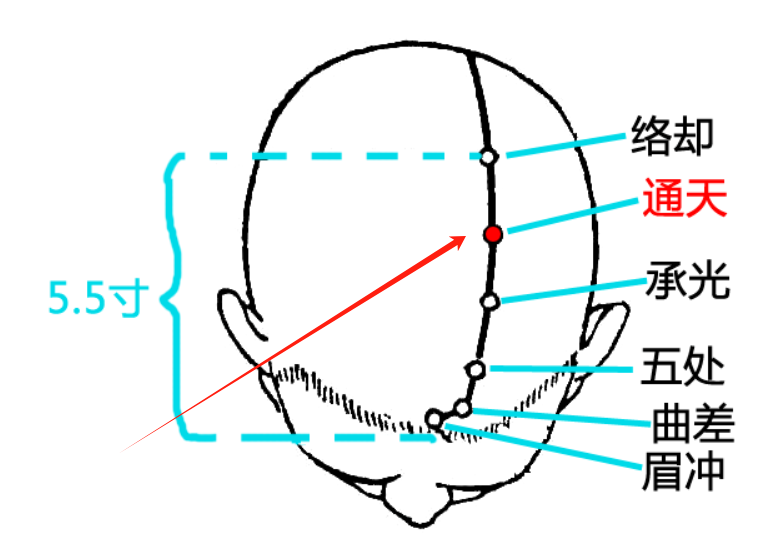Mainly Treated Disease
Nasal Sinusitis
Mnemonic Verse
Nasal sinusitis occurs when the brain and lungs are affected by wind-cold,
The breath is blocked and the nasal discharge is like a spring.
Needle Fengchi, Neiting, Tongtian,
Connect Shenting, Shangxing, and Yingxiang.
Special Efficacy in Treatment
Nasal sinusitis, nasal discharge from the brain, leakage of fluid from the brain, continuous and excessive turbid nasal discharge from the nasal cavity, acute and chronic sinusitis, chronic rhinitis, turbid nasal discharge, nasal polyps, nasal hemorrhoids, nasal polyps
Special Effective Acupoints
Fengchi, Neiting, Tongtian, Shenting, Shangxing, Yingxiang
Introduction of Acupoints
Fengchi: Located in the depression of the hairline at the lower part of Naokong. Pressing it can cause a sensation to reach the ears.
Neiting: Located in the depression at the end of the webbing between the second and third toes of the foot.
Tongtian: Located one cun and five fen behind Chengguang, half a cun in front of Baihui and one cun and half away from the middle line.

Shenting: Located five fen straight into the hairline above the tip of the nose.
Shangxing: Located one cun straight into the hairline above the tip of the nose.
Yingxiang: Located one cun and five fen below the eye, one cun diagonally upward from Heliao, and five fen outside the nasal cavity.
Analysis of Etiology and Pathology
[Analysis 1]: According to “Plain Questions”: In the west, the color is white, which corresponds to the lungs internally and opens into the nose. Nasal congestion is due to cold in the lungs. Clear nasal discharge is due to wind in the lungs. If turbid nasal discharge constantly flows out of the nose without stop, it is called nasal sinusitis. This is because the brain is affected by cold and the cold fails to disperse for a long time, resulting in the continuous flow of turbid nasal discharge like a trickling spring. However, at the beginning, nasal sinusitis is mostly caused by cold, and over time, the cold transforms into heat. There are also nasal polyps, which are called nasal hemorrhoids. They block the airway, give off an unbearable stench, and cause pain that makes it difficult to move. There is also continuous nasal bleeding, which is called epistaxis.
Medical Cases
[Case 1]: Miss Wang, 18 years old, from Hunan Province, lived on Songjiang Road, Taipei City. She suffered from nasal sinusitis with continuous nasal discharge. There was a nasal polyp in the right nostril, blocking the airway completely. This had lasted for several months. On March 9, the 59th year of the Republic of China, introduced by Mr. Yu, she asked for diagnosis and treatment. After needling “Neiting, Fengchi, Tongtian, Shenting, Shangxing, Yingxiang”, she was cured after three successive treatments.
Addition by the Working Group
[Explanation of Traditional Chinese Medicine Disease Name]: Nasal Sinusitis: Commonly known as “leakage of fluid from the brain, leakage of fluid from the brain”, it refers to a disease in which turbid nasal discharge continuously flows from the nasal cavity and fails to heal for years, just like dripping spring water. In severe cases, the nasal discharge gives off a foul smell. It is similar to the diseases such as “acute and chronic sinusitis, chronic rhinitis” in modern medicine. Its symptoms are: “The main feature of this nasal disease is the continuous and excessive turbid nasal discharge. It is often accompanied by headache, nasal congestion, and decreased sense of smell. Over time, there is often a feeling of dizziness”, and it is a common disease in otorhinolaryngology. If not treated thoroughly, it can cause serious complications and even lead to adverse consequences. The term “nasal sinusitis” was first seen in “Plain Questions? Treatise on Qi Syncope”, which states: “When the heat of the gallbladder transfers to the brain, it causes a stinging sensation in the nose and nasal sinusitis. In nasal sinusitis, turbid nasal discharge keeps flowing down”. After that, there were many discussions about nasal sinusitis in successive dynasties of traditional Chinese medicine. Based on the statement in the “Inner Canon of Huangdi” that “the leakage of fluid from the brain is nasal discharge”, disease names such as “leakage of fluid from the brain” and “leakage of fluid from the brain” were proposed. Nasal sinusitis can be divided into excess and deficiency types, and the causes are also different. The excess type is mostly caused by wind-heat in the lung meridian, stagnant heat in the gallbladder, damp-heat in the spleen and stomach, etc., which disturb upward along the meridians, accumulate in the nasal cavity, and damage the mucous membrane. The deficiency type is mostly caused by deficiency of qi and cold in the lungs or deficiency of qi in the spleen, resulting in the nasal cavity lacking the nourishment of qi and blood and the mucous membrane being damaged.
